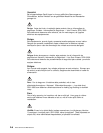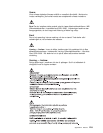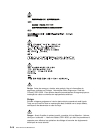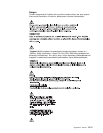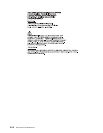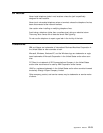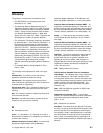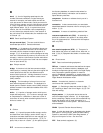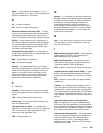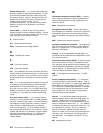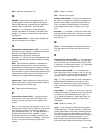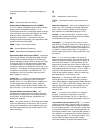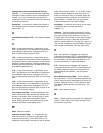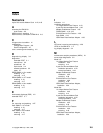B
baud. (1) A unit of signaling speed equal to the
number of discrete conditions or signal events per
second; for example, one baud equals one-half dot
cycle per second in Morse code, one bit per second in
a train of binary signals, and one 3-bit value per second
in a train of signals each of which can assume one of
eight different states. (A) (2) In asynchronous trans-
mission, the unit of modulation rate corresponding to
one unit interval per second; that is, if the duration of
the unit interval is 20 milliseconds, the modulation rate
is 50 baud. (A)
BIOS. Basic Input/Output System.
bits per second (bps). The rate at which bits are
transmitted per second. Contrast with
baud
.
bootstrap. (1) A sequence of instructions whose exe-
cution causes additional instructions to be loaded and
executed until the complete computer program is in
storage. (T) (2) A technique or device designed to bring
itself into a desired state by means of its own action, for
example, a machine routine whose first few instructions
are sufficient to bring the rest of itself into the computer
from an input device. (A)
bps. Bits per second.
bridge. A functional unit that interconnects multiple
LANs (locally or remotely) that use the same logical link
control protocol but that can use different medium
access control protocols. A bridge forwards a frame to
another bridge based on the medium access control
(MAC) address.
bridging. The forwarding of a frame from one local
area network segment to another. The destination is
based upon the medium access control (MAC) sublayer
address encoded in the destination address field of the
frame header.
buffer. (1) A portion of storage used to hold input or
output data temporarily. (2) A routine or storage used
to compensate for a difference in data rate or time of
occurrence of events, when transferring data from one
device to another. (A)
C
C. Celsius.
cache. (1) A special-purpose buffer storage, smaller
and faster than main storage, used to hold a copy of
instructions and data obtained from main storage and
likely to be needed next by the processor. (T) (2) To
place, hide, or store in a cache. (3) An optional part of
the directory database in network nodes where fre-
quently used directory information can be stored to
speed directory searches.
component. Hardware or software that is part of a
functional unit.
connection. In data communication, an association
established between functional units for conveying infor-
mation. (I) (A)
connector. A means of establishing electrical flow.
customer-replaceable unit (CRU). An assembly or
part that a customer can replace in its entirety when
any of its components fail. Contrast with
field replace-
able unit (FRU)
.
D
data terminal equipment (DTE). (1) That part of a
data station that serves as a data source, data sink, or
both. (I) (A) (2) Equipment that sends or receives data,
or both.
dc. Direct current.
DCE. Data circuit-terminating equipment.
DECnet. A network architecture that defines the opera-
tion of a family of software modules, databases, and
hardware components typically used to tie Digital Equip-
ment Corporation systems together for resource
sharing, distributed computation, or remote system con-
figuration. DECnet network implementations follow the
Digital Network Architecture model.
device. A mechanical, electrical, or electronic
contrivance with a specific purpose.
digital. (1) Pertaining to data that consist of digits. (T)
(2) Pertaining to data in the form of digits. (A) (3) Con-
trast with
analog
.
display station. (1) A physical device that can be
used as multiple logical consoles. (2) An input/output
device containing a display screen and an attached key-
board that allows a user to send information to or
receive information from the system. See also
terminal
and
workstation
.
DRAM. Dynamic Random Access Memory.
drop. A cable that leads from a faceplate to the distrib-
ution panel in a wiring closet. When the IBM Cabling
System is used with the IBM Token-Ring Network, a
drop can form part of a lobe. See also
lobe.
DTE. Data terminal equipment. (A)
X-2 2210 Service and Maintenance



